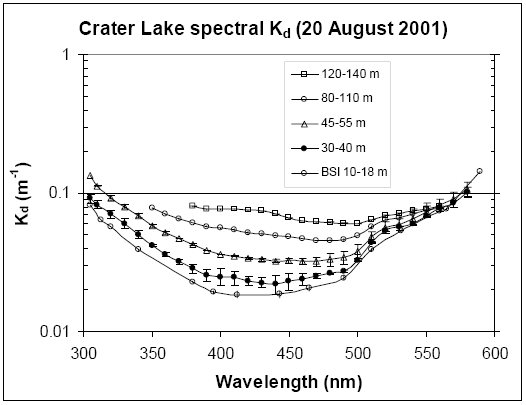Ultraviolet Radiation and Bio-optics in Crater Lake, Oregon, 2005
DISCUSSION
Long-term Proxies for Kd,UV
Development of the Kd,blue signal as a proxy for Kd,UV can be justified from empirical observations in Crater Lake. The attenuation spectra (e.g. Figure 3) near the surface are relatively flat over the response waveband of the combined blue filter and Weston cell sensor using in underwater photometers (Crater Lake Kd averaged over 0–30 m varied spectrally by +36% (Kd,500) and -12% (Kd,400) compared to the mean Kd,400–500; the response bandwidth was 390–490 nm or nominally 400–500 nm). Also, the Kd,UV values measured with the LI-1800uw radiometer gave nearly constant or predictable ratios for Kd,320:Kd,blue, Kd,380:Kd,blue, and Kd,320:Kd,380 in the upper water column (Figure 6). While the LI-1800uw radiometer has not been directly compared with a Kahl blue-filter photometer, the agreement is excellent (Figure 14B) between Kd,blue from UV radiometer and photometer measurements in 1969 that occurred within 10 days of each other. Kd,UV values from radiometer and photometer measurements made in the 1960s were similar to the data from 1996–2002 while on average the Kd,UV values estimated by proxies from the 1980s were higher.
A combination of scattering and absorption contribute to Secchi depth signal and several theoretical and empirical papers have discussed the proportional relationship of 1/ZSD and Kd+cp (Tyler, 1968; Preisendorfer, 1986). Our proxy relationship between 1/ZSD and Kd,blue is based on same-day measurements starting in 1968. While one cannot assume that cp and Kd will change in parallel as conditions in the lake change, we have used the empirical pattern to establish an equation (Kd,blue = 2.08/ZSD – 0.026; r2=0.54, N=13 years) and then convert Kd,blue to Kd,320 or Kd,380 using the relationship described above. Although there are many possible sources of error in the proxy approach relating Kd,UV and 1/ZSD, we estimate from regression residuals (Figure 15A) that annual averages of Kd,320 estimated from Kd,blue will fall within 12% of the values measured with a radiometer. This calculation assumes that conditions from 0–40 m remain within the bounds that Crater Lake has experienced between the earliest paired measurements in 1968 and the present.


